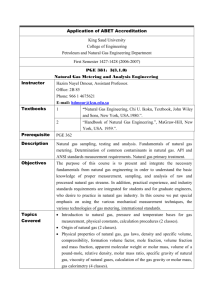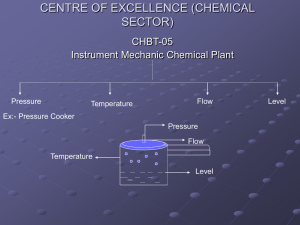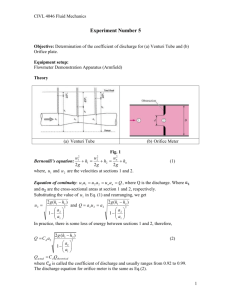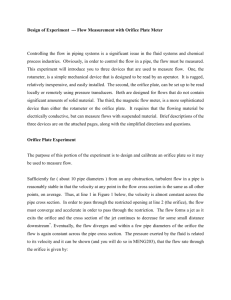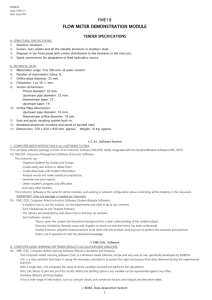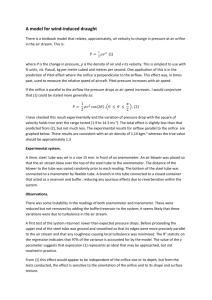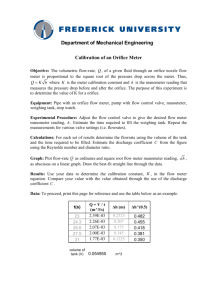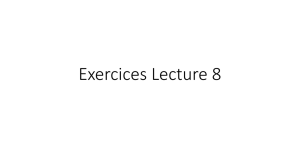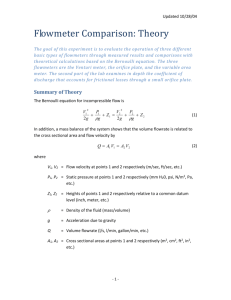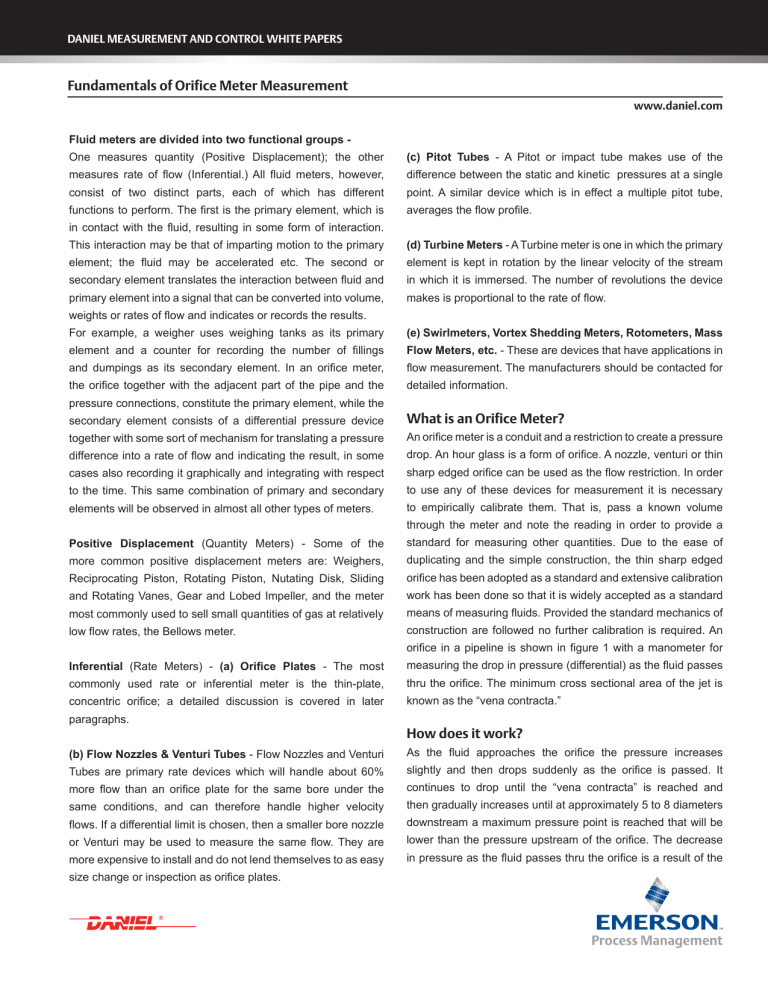
Fundamentals
of Orifice
Meter Measurement
DANIEL
MEASUREMENT
AND CONTROL
WHITE PAPERS
page 1
Fundamentals of Orifice Meter Measurement
www.daniel.com
Fluid meters are divided into two functional groups One measures quantity (Positive Displacement); the other
(c) Pitot Tubes - A Pitot or impact tube makes use of the
measures rate of flow (Inferential.) All fluid meters, however,
difference between the static and kinetic pressures at a single
consist of two distinct parts, each of which has different
point. A similar device which is in effect a multiple pitot tube,
functions to perform. The first is the primary element, which is
averages the flow profile.
in contact with the fluid, resulting in some form of interaction.
This interaction may be that of imparting motion to the primary
(d) Turbine Meters - A Turbine meter is one in which the primary
element; the fluid may be accelerated etc. The second or
element is kept in rotation by the linear velocity of the stream
secondary element translates the interaction between fluid and
in which it is immersed. The number of revolutions the device
primary element into a signal that can be converted into volume,
makes is proportional to the rate of flow.
weights or rates of flow and indicates or records the results.
For example, a weigher uses weighing tanks as its primary
(e) Swirlmeters, Vortex Shedding Meters, Rotometers, Mass
element and a counter for recording the number of fillings
Flow Meters, etc. - These are devices that have applications in
and dumpings as its secondary element. In an orifice meter,
flow measurement. The manufacturers should be contacted for
the orifice together with the adjacent part of the pipe and the
detailed information.
pressure connections, constitute the primary element, while the
secondary element consists of a differential pressure device
What is an Orifice Meter?
together with some sort of mechanism for translating a pressure
An orifice meter is a conduit and a restriction to create a pressure
difference into a rate of flow and indicating the result, in some
drop. An hour glass is a form of orifice. A nozzle, venturi or thin
cases also recording it graphically and integrating with respect
sharp edged orifice can be used as the flow restriction. In order
to the time. This same combination of primary and secondary
to use any of these devices for measurement it is necessary
elements will be observed in almost all other types of meters.
to empirically calibrate them. That is, pass a known volume
through the meter and note the reading in order to provide a
Positive Displacement (Quantity Meters) - Some of the
standard for measuring other quantities. Due to the ease of
more common positive displacement meters are: Weighers,
duplicating and the simple construction, the thin sharp edged
Reciprocating Piston, Rotating Piston, Nutating Disk, Sliding
orifice has been adopted as a standard and extensive calibration
and Rotating Vanes, Gear and Lobed Impeller, and the meter
work has been done so that it is widely accepted as a standard
most commonly used to sell small quantities of gas at relatively
means of measuring fluids. Provided the standard mechanics of
low flow rates, the Bellows meter.
construction are followed no further calibration is required. An
orifice in a pipeline is shown in figure 1 with a manometer for
Inferential (Rate Meters) - (a) Orifice Plates - The most
measuring the drop in pressure (differential) as the fluid passes
commonly used rate or inferential meter is the thin-plate,
thru the orifice. The minimum cross sectional area of the jet is
concentric orifice; a detailed discussion is covered in later
known as the “vena contracta.”
paragraphs.
(b) Flow Nozzles & Venturi Tubes - Flow Nozzles and Venturi
How does it work?
As the fluid approaches the orifice the pressure increases
Tubes are primary rate devices which will handle about 60%
slightly and then drops suddenly as the orifice is passed. It
more flow than an orifice plate for the same bore under the
continues to drop until the “vena contracta” is reached and
same conditions, and can therefore handle higher velocity
then gradually increases until at approximately 5 to 8 diameters
flows. If a differential limit is chosen, then a smaller bore nozzle
downstream a maximum pressure point is reached that will be
or Venturi may be used to measure the same flow. They are
lower than the pressure upstream of the orifice. The decrease
more expensive to install and do not lend themselves to as easy
in pressure as the fluid passes thru the orifice is a result of the
size change or inspection as orifice plates.
DANIEL MEASUREMENT AND CONTROL WHITE PAPERS
page 2
increased velocity of the gas passing thru the reduced area of
Fundamental Gas Laws
the orifice. When the velocity decreases as the fluid leaves the
All matter is composed of exceedingly tiny particles called
orifice the pressure increases and tends to return to its original
molecules A molecule is defined as the smallest particle which
level. All of the pressure loss is not recovered because of
can exist in the free and undecomposed state, i.e., natural
friction and turbulence losses in the stream. The pressure drop
gas is composed of molecules of methane, ethane, etc. These
across the orifice ( P in Fig. 1) increases when the rate of flow
molecules are in constant motion and it is the impact of these
increases. When there is no flow there is no differential. The
molecules on the sides of a container which is measured as
differential pressure is proportional to the square of the velocity,
pressure. Temperature regulates the speed of the molecules
it therefore follows that if all other factors remain constant, then
and therefore, an increase in temperature increases the motion
the differential is proportional to the square of the rate of flow.
of the molecules which in turn increases the pressure.
Orifice Flow Measurement - History
As decreased temperature and pressure causes decreased
The first record of the use of orifices for the measurement of fluids
was by Giovanni B. Venturi, an Italian Physicist, who in 1797 did
some work that led to the development of the modern Venturi
Meter by Clemons Herschel in 1886. It has been reported that
an orifice meter, designed by Professor Robinson of Ohio State
University was used to measure gas near Columbus, Ohio,
about 1890. About 1903 Mr. T.B. Weymouth began a series of
tests in Pennsylvania leading to the publication of coefficients
for orifice meters with flange taps. At the same time Mr. E.O.
Hickstein made a similar series of tests at Joplin, Missouri, from
which he developed data for orifice meters with pipe taps.
A great deal of research and experimental work was conducted
by the American Gas Association and the American Society of
Mechanical Engineers between 1924 and 1935 in developing
orifice meter coefficients and standards of construction for orifice
meters. In 1935 a joint A.G.A. - A.S.M.E. report was issued title
“History of Orifice Meters and The Calibration, Construction, and
Operation of Orifices For Metering.” This report is the basis for
most present day orifice meter measurement installation. An
updated version of this standard based on new data was issued
in early 1991 by A.P.I. titled: Manual of Petroleum Measurement
Standards, Chapter 14, Section 3, Parts 1-4. Several additional
publications are available to simplify measurement by orifice
meters. These are: ASME Fluid Meters 6th Edition, ASME
motion of the molecules, it follows there must be some point
where there is no molecular activity. The points where there is no
molecular activity are absolute zero temperature (approximately
-460°F) and absolute zero pressure (approximately 14.7 pounds
per square inch below atmospheric pressure). Absolute pressure
is equal to gauge pressure plus atmospheric pressure (14.7
p.s.i.). Absolute temperature is equal to degrees Fahrenheit (°F)
plus 459.67° and is called degrees Rankin.
Boyles Law states that in an ideal gas the volume is inversely
proportional to the absolute pressure. If a cylinder has a volume
of gas at an absolute pressure of 14.7 and a piston was to
displace the volume in the cylinder until the pressure reached
29.4 p.s.i., then the cylinder would contain one-half of its original
volume.
Charles Law states that the volume of an ideal gas is directly
proportional to the absolute temperature. If a cylinder has a
volume of gas at 60°F or 514.67° Rankin (absolute) and a piston
was used to displace the volume so as to maintain a constant
pressure while the temperature was doubled to the 580°F or
1039.67° Rankin (absolute) the cylinder would contain twice its
original volume.
The combined ideal Boyles and Charles Law is commonly
written in the form of the equation:
Power Test Code, Chapter 4 on Flow Measurement and Flow
Measurement Engineering Handbook by R.W. Miller.
When discussing a quantity of gas it is necessary to define it. We
could use weight such as pounds or ounces but it is difficult for
most people to think of gas as having weight. So, the common
definition is a cubic foot at some base pressure and base
temperature. The base conditions used by most areas of
the United States are 14.73 p.s.i.a. and 60°F. See USEFUL
FORMULAS on page 8.
Typical Orifice Flow Pattern Flange Taps Shown
Note: See pressure recovery curves on page 7
Where:
P = Pressure at Condition 1 or 2
1 = Flowing Conditions
V = Volume at Condition 1 or 2
2 = Base Conditions
T = Temperature at Condition 1 or 2
Fundamentals of Orifice Meter Measurement
ORIFICE GAS FLOW EQUATION
Qv = 218.527*Cd*Ev*Y1*(d )*[Tb/Pb]*[(Pf1*Zb*hw)/(Gr*Zf1*Tf)] (3-6)
2
0.5
Where
Cd = Orifice plate coefficient of discharge
d = Orifice plate bore diameter calculated at flowing temperature
(Tf) - in.
Gr = Real gas relative density (specify gravity)
hw = Orifice differential pressure in inches of water at 60 degF
Ev = Velocity of approach factor
Pb = Base pressure - psia
Pf1 = Flowing pressure (upstream tap - psia
Qv = Standard volume flow rate - SCF/hr.
Tb = Base temperature - degR
Tf = Flowing temperature - degR
Y2 = Expansion factor (downstream tap)
Zb = Compressibility at base conditions (Pb,Tb)
Zf1 = Compressibility (upstream flowing conditions - Pf1, Tf)
page 3
Orifice Differential Pressure in Inches of Water at
60 degF - hw
This is a measure of the pressure drop across the orifice and is
measured in inches of water. (Note: Approximately 27.7 inches
of water is equal to one pound drop.)
Velocity of Approach Factor - Ev
This factor corrects for the change in velocity between the
upstream meter tube and the velocity in the orifice bore. This
factor varies with the beta ratio.
Base Pressure (psia) - Pb
To define the quantity of a gas measured, the base pressure
must be defined. This is set by contract, governmental law or
agreement by the two parties to the measurement. The AGA-3
used 14.73 psia as its base pressure.
Flowing Pressure (psia) Pf1 or 2
The pressure is measured at either the upstream (1) or
downstream (2) tap. It has been common in the natural gas
Orifice Plate Coefficient of Discharge - Cd
This has been empirically determined for flange-tapped orifice
meters. To accurately use these coefficients, the orifice meter
must be manufactured to the specifications of Chapter 14 Natural Gas Fluids Measurement of the manual of Petroleum
Measurement Standards Section 3 Concentric, Squareedge
Orifice Meters Part 2 Specifications and Installation
Requirements (Also referenced as AGA Report No. 3, Part 2
and GPA 8185-9, Part 2). Basically, the coefficient of discharge
depends on the Reynolds number, sensing tap location, meter
tube diameter and orifice diameter with some other smaller
influences.
Each coefficient of discharge applies to the Reynolds number
at which it is calculated.
Orifice Plate Bore Diameter - d
This bore must represent the bore at flowing conditions so
corrections to account for the effects of temperature must
be made if the temperature at which the plate was miked is
different from the flowing temperature.
Real Gas Relative Density (Specific Gravity) - Gr
This is the normal specific gravity obtained from a specific
gravity test or recording instrument and represents the ratio
of the relative densities of the gas, divided by air at the same
conditions. With a given applied force to a gas, a larger
quantity of .25 specific gravity gas can be passed through an
orifice than a 1.00 specific gravity gas. Since flow varies as the
square root of one over the specific gravity twice as much gas
will flow with the lighter gas,
business to use the downstream tap. Pressure has two effects
on volume. The higher pressure makes the gas denser so less
volume flows through the meter. However, when the volume is
expanded to base pressure, the volume is increased.
Base Volume Flow Rate - Qr
The standard equation calculates an hourly volume rate which
must be multiplied by time to get total volume. The volume is
expressed at the base conditions of temperature and pressure.
Base Temperature in Degrees Rankin - Tb
The base temperature is defined by the contract, governmental
law or agreement by the two parties to the measurement. To
correct degrees Fahrenheit to degrees Rankin, 459.67 degrees
is added. Most natural gas uses 519.67°R (i.e. 60°F + 459.67°)
as the base temperature.
Flowing Temperature in Degrees Rankin - Tf
The flowing temperature is normally measured downstream
from the orifice and must represent the average temperature
of the flowing stream in degrees Rankin. Temperature has two
effects on volume. A higher temperature means a less dense
gas and higher flows, but when this higher flow is corrected to
base temperature, the base flow is less.
Expansion Factor - Y1 or 2
The expansion factor corrects for the density change between
the measured tap density and the density at the plane of the
orifice face. Since the common static pressure tap used in
natural gas measurement is the downstream factor Y2; this
factor is smaller than the Y1 correction.
DANIEL MEASUREMENT AND CONTROL WHITE PAPERS
page 4
Compressibility at Base Conditions (Pb Tb)
The Three “R’s” Reliability (uncertainty/accuracy)
This correction is very close to one so in the past it has been
The coefficients calculated for flange taps by the equations in
ignored. However, since 1985 it has been required to correct for
AGA Report No. 3 (API 14.3) are subject to an uncertainty of
the gas compressibility from the base pressure to absolute zero
approximately + .5 percent when the beta ratio is between 0.20
pressure at 60° F.
and 0.70. When the beta ratio is between 0.10 & 0.20 and .70 &
Compressibility Flowing conditions (Pf and Tf) Zf 1
or 2
.75, the uncertainty may be greater. Minimum uncertainty occurs
between 0.2 and 0.6 beta ratios. Below 1,000,000 Reynolds
number there will be some small increase in uncertainty with
The real gases compress more than the ideal gas law predicts
the minimum Reynolds number of 4,000 being the limit of the
and this must be corrected for when gas is measured at high
standard.
pressure and temperatures other than 60°F mathematically
reduced to base conditions. This correction, when applied
Rangeability
outside of the square root radical is called supercompressibility.
Sometimes called “turn-down” is the ratio of maximum flow to
In round numbers at ambient temperature the compressibility
minimum flow throughout which a stated accuracy is maintained.
affects volume by 0.5 percent per 100 psi of pressure.
For example, if an orifice meter installation is said to be accurate
Critical Flow
to + 1% from 600,000 SCFH to 200,000 SCFH, the rangeability
would be 3 to 1.
The above square root flow formula applies to subsonic flow
only. Sonic or critical flow occurs when the velocity of the gas or
Repeatability
vapor reaches the speed of sound (approx. 700 miles per hour
The ability of a flow meter to indicate the same readings each
in air). A gas cannot be made to travel any faster and remain in
time the same flow conditions exist. These readings may or may
the same state.
not be accurate, but will repeat. This capability is important
A rule of thumb to use in gas flow is that critical flow is reached
when a flow meter is used for flow control.
when the downstream pipe tap registers an absolute pressure of
It should be noted that total system pressure loss should be
approximately 50% or less than the upstream pipe tap.
based on amount of differential created at a given beta ratio for
Major Advantage of Orifice Meter Measurement
a given flow. Devices having a lower coefficient of discharge
may not have a lower permanent loss for the same flow.
Flow can be accurately determined without the need for actual
fluid flow calibration. Well established procedures convert the
PRESSURE LOSS CHARACTERISTICS OF PRIMARY DEVICES
differential pressure into flow rate, using empirically derived
coefficients. These coefficients are based on accurately
The Orifice Plate
measurable dimensions of the orifice plate and pipe diameters
The orifice plate bore can be made in many configurations to
as defined in standards, combined with easily measurable
handle various flow measurement jobs. The flowing conditions
characteristics of the fluid, rather than on fluid flow calibrations.
should be checked to see which of the configurations is suitable
With the exception of the orifice meter, almost all flow meters
for each measurement job.
require a fluid flow calibration at flow and temperature conditions
closely approximating service operation in order to establish
a. The Thin Plate, Concentric Orifice
accuracy.
In the design and use of orifice plates, several basic factors
In addition to not requiring direct fluid flow calibration, orifice
must be followed to assure accurate and reliable measurement.
meters are simple, rugged, widely accepted, reliable and
relatively inexpensive.
The upstream edge of the orifice must be sharp and square.
No moving parts!
Minimum plate thickness based on pipe I.D., orifice bore, etc. is
standardized. The plate should not depart from flatness along
BETA RATIO is the ratio of orifice plate bore divided by pipe I.D.
any diameter by more than 0.01 inch per inch of the dam height
is referred to as the Beta Ratio or d/D where d is the plate bore
(D-d)/2. To conform with recommended practices, the orifice-to-
and D is the pipe I.D.
pipe diameter ration d/D (called Beta ratio), must not exceed
recommended limits.
Fundamentals of Orifice Meter Measurement
page 5
b. Eccentric Orifice Plates
The Primary Element Orifice Flanges
The eccentric plate has a round opening (bore) tangent to the
The most elementary device used to hold an orifice plate in place
is the orifice flange union. Orifice flanges have been used for a
great many years but gained in importance during the 1920’s,
when the petroleum industry began making extensive use of
orifice measurement. It did not take many years to discover that
the orifice flange, in spite of simplicity, had many shortcomings
in certain applications. It was apparent that it could not be
conveniently used for wide variations of flow, dirty fluids requiring
frequent plate cleanings, or in services where flow interruptions
are expensive. Therefore, it was often necessary to bypass the
flow so that the orifice plate could be inspected or changed as
inside wall of the pipe. This type of plate is most commonly used
to measure fluids which carry a small amount of non-abrasive
solids, or gases with small amounts of liquid, since with the
opening at the bottom of the pipe, the solids and liquids will carry
through, rather than collect at the orifice plate.
c. Segmental Orifice Plates
The opening in a segmental orifice plate is comparable to a
partially opened gate valve. This plate is generally used for
measuring liquids or gases which carry non-abrasive impurities
such as light slurries or exceptionally dirty gases. Predictable
accuracy of both the eccentric and segmental plate is not as
good as the concentric plate.
d. Quadrant Edge Plate
The quarter-circle or quadrant orifice is used for fluids of high
viscosity. The orifice incorporates a rounded edge of definite
radius which is a particular function of the orifice diameter.
e. Conic Edge Plate
The conic edge plate has a 45° bevel facing upstream into the
flowing stream. It is useful for even lower Reynolds numbers
than the quadrant edge.
Meter Tap Location
a. Flange Taps
These taps are located one inch from the upstream face of the
orifice plate and one inch from the downstream face with a +
1/64 to +1/32 tolerance.
b. Pipe Taps
These taps are located 2½ pipe diameters upstream and 8 pipe
diameters downstream (point of maximum pressure recovery).
Flange taps are almost universally used in the United States
with some older meter stations still using pipe taps.
c. Vena - Contracta Taps
These taps are located one pipe diameter upstream and at the
point of minimum pressure downstream (this point is called the
vena-contracta). This point, however, varies with the Beta ratio
and they are seldom used in other than plant measurement
where flows are relatively constant and plates are not changed.
Exact dimensions are given in appropriate tables.
d. Corner Taps
These taps are located immediately adjacent to the plate faces,
upstream and downstream. Corner taps are most widely used
in Europe, in line sizes less than 2 inches they are used with
special honed flow meter tubes for low flow rates.
conditions warranted.
The Senior Orifice Fitting
®
Changing plates in orifice flanges is time consuming and
expensive. It is evident that operating personnel are in need of
some device which would make the operation of plate changing
or inspection less tedious. Therefore, the first significant type
of orifice fitting is known as the Senior type, having a design
permitting the change or the removal of a plate under flowing
conditions.
The Senior Orifice Fitting is a dual chambered fitting allowing
®
the removal of an orifice plate under flow conditions. The lower
chamber, which holds the orifice plate in the fluid flow, is bolted
to an upper chamber. Separating the two chambers is a slide
valve that opens/closes with a gear shaft. Opening the slide
valve allows elevation of the plate carrier and orifice plate into
the top chamber. Once the slide valve is closed again and
pressure bled from the top chamber, the plate carrier/plate can
be removed to the atmosphere.
The Junior Orifice Fitting
Some time after the development of the Senior Orifice Fitting,
attention was given to the problem of changing orifice plates
when a bypass was in existence, or where two or more meter
tubes were joined by common headers. Since orifice flanges
are not convenient and require a considerable amount of time
when used, thought was turned to developing a simple fitting
for speedy operating. The result was the Junior type fitting. The
Junior Fitting is much like the Senior, except the Junior does not
have a slide valve and a top chamber. The Junior fitting requires
only the following steps to remove an orifice plate from the line:
1.
Shut in meter tube.
2.
Depressure tube.
3.
Loosen set screws, remove top clamping bar, sealing bar,
and gasket.
4.
Turn shaft, elevating orifice plate out of the fitting.
The procedure is reversed to install an orifice plate.
DANIEL MEASUREMENT AND CONTROL WHITE PAPERS
page 6
The Junior Fitting is currently available in line sizes 10” through
volume meter stations, the Junior fittings saves the time and
34” and for special applications, has been manufactured in
trouble of breaking apart large orifice flanges. All Juniors are
larger sizes up to 48”.
made to AGA/API recommendations.
The Simplex Orifice Plate Holder
Daniel Simplex Orifice Plate Holders
®
®
The Simplex Orifice Plate Holder is the third basic type of orifice
fitting, and was developed specifically to provide an economical,
accurate replacement for conventional orifice flanges where
plate changings are infrequent and orifice flange unions are too
cumbersome. The Simplex is basically the same as the Junior
except you do not elevate the orifice plate with a shaft and pinion
gear. Since the Simplex is made in sizes 1½ “ thru 8” only, the
plate and plate carrier can easily be removed by hand.
On line sizes of 1½” through 8”, where line by-pass or pressure
Daniel Senior Orifice Fittings
®
shut-down is permitted, Simplex Orifice Plate Holders offer
more convenience and operating economy than orifice flanges.
First, Universal Size plates are used instead of more expensive
paddle-type plates. Secondly, plate removal is faster, safer and
simpler. Finally, the line does not have to be jacked apart nor
liquid product spilled. Four types of end connections (body
styles) are available. All Simplex Plate Holders are made to
AGA/API recommendations. Pressure ratings are available to
10,000 PSI.
Daniel Senior® Orifice Fittings are made to provide the
Daniel Orifice Meter Tubes
best possible conditions for orifice metering accuracy and
All Daniel Meter tubes are manufactured to meet or exceed the
convenience. They also meet AGA/API recommendations for
recommendations of AGA, API and other societies. Tubing is
sizes and tolerances, pressure ratings and tap locations Senior
made to Daniel specifications at the mill to guarantee uniform
Orifice Fittings have the dual chamber design that permits
roundness, wall thickness and strength. Automatic welding, and
the orifice plate to be removed from pressurized lines safely
special internal alignment methods are employed. Extra pipe
and quickly. For operators, this means considerable savings.
connections are available. All critical location welds are ground
Regular inspection and replacement of orifice plates results in
internally and all others where possible. X-ray and hydrostatic
higher accuracy and more economy.
testing are available.
Senior Orifice fittings are available in line sizes from 2” through
Orifice fittings and orifice flanges are available in a wide variety
48” and pressure ratings up to 10,000 PSI WOG.
of end connections and care is taken to ensure against steps or
Daniel Junior Orifice Fittings
offsets in the line bore between tube and fitting.
For bore inspection, the “Flangnek” body style of fitting is
recommended because the down stream tube section can
be unbolted at the flange, inspection made and the important
upstream alignment left undisturbed.
Daniel bolts together all meter tubes before shipment when
length permits.
Meter Tubes
On line sizes of 10” to 48”, where line by-pass or pressure shutdown is permitted, Junior Orifice Fittings are advantageous to
use. The Junior is a single chamber fitting with all of the qualities
of Senior Fittings except plate removal under pressure. To raise
the plate carrier a operating shaft is provided. Designed for large
In recent years many companies have joined with industry to
study the effects of the upstream and the downstream pipe
immediately adjacent to the orifice plate. These lengths of pipe
are known as meter tubes, meter runs, flow sections, meter
sections, etc.; however, the most generally accepted terminology
is meter tubes. It has been clearly demonstrated by tests that
Fundamentals of Orifice Meter Measurement
page 7
the length and the condition of the pipe used in meter tubes
Recording orifice meters come equipped with one, two or three
has a very important bearing on the overall accuracy of the
pens. For liquid measurement a single pen for differential
measurement. The proper manufacture of orifice meters and
pressure is all that is required. For gas, two pens are required
orifice fittings is a highly developed technology.
in order to account for changes in
static
Visual Manometers
pressure.
If
significant
temperature changes are anticipated,
A manometer in its simplest form is a glass tube bent in the
a third pen or a separate recorder is
form of the letter “U” and partially filled with some liquid. If both
used. In order to know which pen line
ends of the “U” are open to atmosphere, the pressure on each
is which, Red ink is normally used for
side would be alike, and the column of liquid on the one side
differential pressure and Blue or
of the “U” tube will exactly balance the column of liquid on the
Black for static pressure. There is no
other side, and the surface of the two heights will be on the
set color for temperature.
same level. If one leg of the “U” is connected to a supply pipe
To facilitate the estimation of flow at
in which the pressure is a little greater than the other leg, then
any point in time, orifice charts may
the column of liquid will be down on the high pressure side and
be graphed on a square root scale rather than a liner scale. The
up on the low pressure side, and the difference in height is a
following comparison graph shows the relationship of these two
true measure of the difference in pressure (pressure drop) in
scales.
the two legs of the manometer. Because the visual manometer
is basic in calibration, friction-free, and simple, it is used in field
General Installation Recommendations
and laboratory calibrations of primary devices.
1.
calibration as well as to protect the differential element
Bellows or Dry Type Differential Meter
This type meter uses concentrically corrugated diaphragms
against overange.
2.
or bellows. Modern designs use two bellows with the space
between filled with liquid. This liquid prevents deformation at
3.
Always slope the manifold lines gently from the orifice
fitting to the meter to eliminate any high or low points in the
adjustable damping device between the two bellows.
The DP transducer measures the differential pressure and
The meter should be installed as close as possible to the
orifice fitting.
high over-range conditions and makes it possible to install an
Differential Pressure (DP) Cells
Meter manifold piping should always be installed to enable
manifold lines.
4.
Use condensate chambers or air traps to remove either
liquid from a gas system or gas from a liquid system if lows
or highs in the manifold piping cannot be avoided.
converts the reading to an electrical signal for input into a flow
computer. The latest DP’s are “smart transducers” that correct
It is important when pressurizing or depressurizing differential
for the effects of temperature and pressure and are more stable
measuring devices to apply or release pressure to or from the
than the standard DP’s.
high and low meter chambers uniformly, so as not to impose
Recording Charts
excessive overange.
Most orifice meter recording charts are circular and will revolve
Pressurize
one revolution every 1 hour, 24 hours, 7 days, 8 days, or any
A) Be sure (1) & (2) are closed (if not, follow depressurize
other pre-determined length of time. The chart should be
procedure).
B) Open (3), (4), (5), & (6) and close (7).
C) Slowly open (1) & (2).
D) Close (5) & (6) and open (7).
Depressurize
replaced when the time period is completed. This is done either
A) Close (7).
manually or by automatic chart changers.
B) Open (5) & (6).
C) Close (3)& (4) (or (1) & (2) if checking piping for leakage).
D) Slowly open (7) (this will evenly vent hi & low sides).
DANIEL MEASUREMENT AND CONTROL WHITE PAPERS
Pressure correction
Absolute pressure = gage pressure + 14.73 = psia
Q new=
XQ Where P1 = Old psia
P2 = New psia
Example: if Q old = 100,000 SCFH @ 100 psig (old)
What would flow be at 200 psig (new)
100 psig = 114.73 psia
200 psig = 214.73 psia
Q new=
Temperature correction
Absolute temperature = °F + 460 = °R (Rankin)
Q new=
Example: if Q old = 100,000 SCFH @ 60°F
What would flow be at 70°F
60°F = 520°R
70°F = 530°R
Q new=
page 8
Emerson Process Management
Daniel Measurement and Control, Inc.
www.daniel.com
North America / Latin America:
Headquarters
USA - Houston, Texas
T +1.713.467.6000
F +1.713.827.3880
USA Toll Free 1.888.FLOW.001
Europe: Stirling, Scotland, UK
T +44.1786.433400
F +44.1786.433401
Middle East, Africa: Dubai, UAE
T +971.4.811.8100
F +971.4.886.5465
Asia Pacific: Singapore
T +65.6777.8211
F +65.6777.0947 / 0743
Daniel Measurement and Control, Inc. is a wholly owned subsidiary of Emerson Electric Co., and a
division of Emerson Process Management. The Daniel name and logo are registered trademarks
of Daniel Industries, Inc. The Emerson logo is a registered trademark and service mark of
Emerson Electric Co. All other trademarks are the property of their respective companies. The
contents of this publication are presented for informational purposes only, and while every
effort has been made to ensure their accuracy, they are not to be construed as warranties or
guarantees, expressed or implied, regarding the products or services described herein or their use
or applicability. All sales are governed by Daniel’s terms and conditions, which are available upon
request. We reserve the right to modify or improve the designs or specifications of such products
at any time. Daniel does not assume responsibility for the selection, use or maintenance of any
product. Responsibility for proper selection, use and maintenance of any Daniel product remains
solely with the purchaser and end-user.
©2010 Daniel Measurement and Control, Inc. All Rights Reserved. Unauthorized duplication in whole or in part is prohibited. Printed in the USA.
DAN-TECHNOLOGIES-FUNDAMENTALS-OF-ORIFICE-METER-MEASUREMENT

